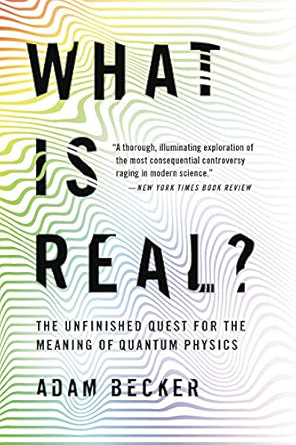More on this book
Community
Kindle Notes & Highlights
by
Adam Becker
Started reading
October 11, 2024
“shut up and calculate,” in the words of physicist David Mermin.
Einstein pointed out, “The theory decides what we can observe.”
The practice of science itself depends on the total content of our best scientific theories—not just the math but the story of the world that goes along with the math.
This is a story of science as a human endeavor—not just a story about how nature works but also about how people work.
Werner Heisenberg, the first person to glimpse the full mathematical form of quantum physics,
Bell graduated from university in 1949, he stumbled upon a book by Max Born, another architect of quantum physics.
von Neumann had proven that the Copenhagen interpretation was the only possible
David Bohm had found another way to understand quantum physics.
Bell finally returned to it—and made the most profound discovery about the nature of reality since Einstein.
quantum physics, had a more difficult birth.
Institute for Theoretical Physics in Copenhagen
What does quantum physics tell us about the world?
very simple answer: quantum physics tells us nothing whatsoever about the world.
Copenhagen interpretation states that quantum physics is merely a tool for calculating the probabilities of various outcomes of experiments.
only an abstract quantum physical description.”
Heisenberg put it, “The idea of an objective real world whose smallest parts exist objectively in the same sense as stones or trees exist, independently of whether or not we observe them, is impossible.”
Einstein couldn’t stand the Copenhagen interpretation.
Von Neumann
was one of the founding fathers of computer science.
Why does quantum physics need an interpretation?
not immediately clear what the theory is saying about the world.
If you want to know where an electron is, you need more than three numbers—you need an infinity of them.
called wave functions
That’s what a wave function is, at its simplest: a set of numbers, fixed at different places.
Schrödinger equation ensures that wave functions always change smoothly—
Nobody’s ever seen half of an electron, or anything less than a whole electron in one well-defined place.
predictions of quantum physics are generally in terms of probabilities, not certainties.
Rather than following the Schrödinger equation like a good wave function, it collapses—it instantly becomes zero everywhere except in the place where you found the electron.
This is so weird that it gets a special name: the measurement problem
Why does the Schrödinger equation only apply when measurements aren’t happening?
maybe quantum physics really is different.
what is a “measurement,” anyhow?
And where’s the divide between the quantum world of the small and the Newtonian world of the large?
it means there’s something about the nature of reality that we don’t understand.
no connection to the world around us at all—it’s merely a useful piece of mathematics.
between measurements, nothing matters.
So what is real?
Einstein, and later on, Bell and Bohm—did so in open defiance of Copenhagen.
different kinds of atoms each have their own distinct spectrum of colors, like a fingerprint.
they didn’t understand what kind of internal atomic structure could be producing these spectra.
Ernest Rutherford, Bohr proposed a “planetary” model
discontinuous jumps of certain energies were known as quanta,
was also incomplete, as Bohr well knew.
could explain the colors in hydrogen’s spectrum but not the relative brightness of those colors.
Put an atom in a magnetic field, and its spectrum changed. Put it in an electric field, and its spectrum changed in a different way. Colors shifted, blurred, and split, dimmed and brightened, with no larger pattern in sight—until Heisenberg.
Heisenberg made a breakthrough.
developed a strange new mathematics on the fly,
allowed him to predict how atomic spectra respond to magnetic fields.
Born and his student Pascual Jordan helped Heisenberg to elucidate the structure and implications of his new theory, which Born dubbed “matrix mechanics” after the unfamiliar mathematical objects at its heart.
thermodynamics, developed in the early 1800s, were the very model of a modern physical theory,


